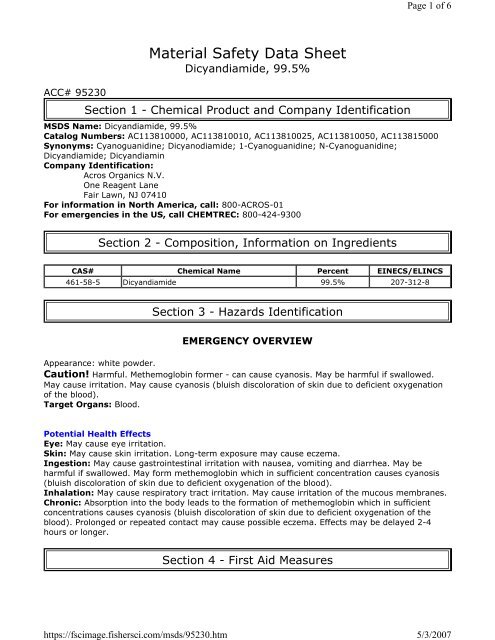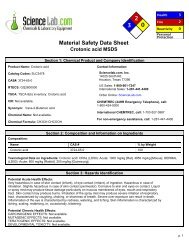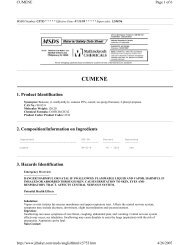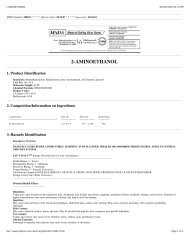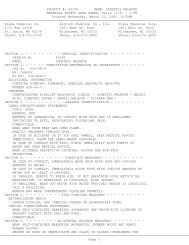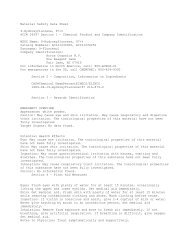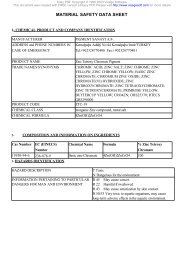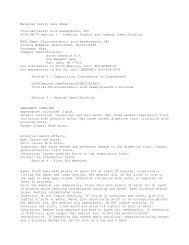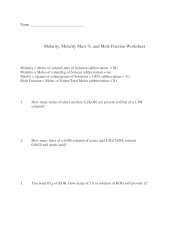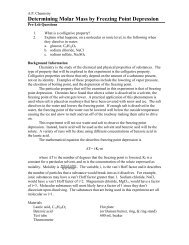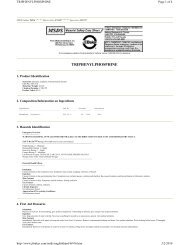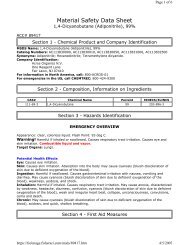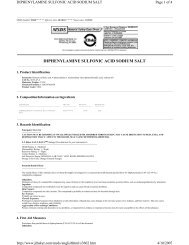MSDS PDF/D/Dicyandiamide.pdf
MSDS PDF/D/Dicyandiamide.pdf
MSDS PDF/D/Dicyandiamide.pdf
You also want an ePaper? Increase the reach of your titles
YUMPU automatically turns print PDFs into web optimized ePapers that Google loves.
https://fscimage.fishersci.com/msds/95230.htmPage 1 of 65/3/2007ACC# 95230Material Safety Data Sheet<strong>Dicyandiamide</strong>, 99.5%Section 1 - Chemical Product and Company Identification<strong>MSDS</strong> Name: <strong>Dicyandiamide</strong>, 99.5%Catalog Numbers: AC113810000, AC113810010, AC113810025, AC113810050, AC113815000Synonyms: Cyanoguanidine; Dicyanodiamide; 1-Cyanoguanidine; N-Cyanoguanidine;<strong>Dicyandiamide</strong>; DicyandiaminCompany Identification:Acros Organics N.V.One Reagent LaneFair Lawn, NJ 07410For information in North America, call: 800-ACROS-01For emergencies in the US, call CHEMTREC: 800-424-9300Section 2 - Composition, Information on IngredientsCAS# Chemical Name Percent EINECS/ELINCS461-58-5 <strong>Dicyandiamide</strong> 99.5% 207-312-8Section 3 - Hazards IdentificationEMERGENCY OVERVIEWAppearance: white powder.Caution! Harmful. Methemoglobin former - can cause cyanosis. May be harmful if swallowed.May cause irritation. May cause cyanosis (bluish discoloration of skin due to deficient oxygenationof the blood).Target Organs: Blood.Potential Health EffectsEye: May cause eye irritation.Skin: May cause skin irritation. Long-term exposure may cause eczema.Ingestion: May cause gastrointestinal irritation with nausea, vomiting and diarrhea. May beharmful if swallowed. May form methemoglobin which in sufficient concentration causes cyanosis(bluish discoloration of skin due to deficient oxygenation of the blood).Inhalation: May cause respiratory tract irritation. May cause irritation of the mucous membranes.Chronic: Absorption into the body leads to the formation of methemoglobin which in sufficientconcentrations causes cyanosis (bluish discoloration of skin due to deficient oxygenation of theblood). Prolonged or repeated contact may cause possible eczema. Effects may be delayed 2-4hours or longer.Section 4 - First Aid Measures
https://fscimage.fishersci.com/msds/95230.htmPage 2 of 65/3/2007Eyes: Immediately flush eyes with plenty of water for at least 15 minutes, occasionally lifting theupper and lower eyelids. Get medical aid imme diately.Skin: Get medical aid. Flush skin with plenty of water for at least 15 minutes while removingcontaminated clothing and shoes.Ingestion: Never give anything by mouth to an unconscious person. Get medical aid immediately.Do NOT induce vomiting. If conscious and alert, rinse mouth and drink 2-4 cupfuls of milk or water.Inhalation: Remove from exposure and move to fresh air immediately. If not breathing, giveartificial respiration. If breathing is difficult, give oxygen. Get medical aid.Notes to Physician: Treat symptomatically and supportively.Section 5 - Fire Fighting MeasuresGeneral Information: As in any fire, wear a self-contained breathing apparatus in pressuredemand,MSHA/NIOSH (approved or equivalent), and full protective gear. During a fire, irritatingand highly toxic gases may be generated by thermal decomposition or combustion. Dust can be anexplosion hazard when exposed to heat or flame.Extinguishing Media: Use water spray, dry chemical, carbon dioxide, or appropriate foam.Flash Point: Not applicable.Autoignition Temperature: Not applicable.Explosion Limits, Lower:Not available.Upper: Not available.NFPA Rating: (estimated) Health: 1; Flammability: 0; Instability: 1Section 6 - Accidental Release MeasuresGeneral Information: Use proper personal protective equipment as indicated in Section 8.Spills/Leaks: Sweep up, then place into a suitable container for disposal. Avoid generating dustyconditions. Provide ventilation.Section 7 - Handling and StorageHandling: Wash thoroughly after handling. Remove contaminated clothing and wash before reuse.Use with adequate ventilation. Minimize dust generation and accumulation. Avoid contact witheyes, skin, and clothing. Avoid ingestion and inhalation.Storage: Keep container closed when not in use. Store in a cool, dry area away from incompatiblesubstances.Section 8 - Exposure Controls, Personal ProtectionEngineering Controls: Facilities storing or utilizing this material should be equipped with aneyewash facility and a safety shower. Use adequate ventilation to keep airborne concentrationslow.Exposure LimitsChemical Name ACGIH NIOSH OSHA - Final PELs
https://fscimage.fishersci.com/msds/95230.htmPage 3 of 65/3/2007<strong>Dicyandiamide</strong> none listed none listed none listedOSHA Vacated PELs: <strong>Dicyandiamide</strong>: No OSHA Vacated PELs are listed for this chemical.Personal Protective EquipmentEyes: Wear appropriate protective eyeglasses or chemical safety goggles as described by OSHA'seye and face protection regulations in 29 CFR 1910.133 or European Standard EN166.Skin: Wear appropriate protective gloves and clothing to prevent skin exposure.Clothing: Wear appropriate protective clothing to prevent skin exposure.Respirators: A respiratory protection program that meets OSHA's 29 CFR 1910.134 and ANSIZ88.2 requirements or European Standard EN 149 must be followed whenever workplaceconditions warrant respirator use.Section 9 - Physical and Chemical PropertiesPhysical State: PowderAppearance: whiteOdor: no odorpH: Not available.Vapor Pressure: Negligible.Vapor Density: Not available.Evaporation Rate:Not available.Viscosity: Not available.Boiling Point: Not available.Freezing/Melting Point:208.00 - 211.00 deg CDecomposition Temperature:Not available.Solubility: 2.26% @ 13 °CSpecific Gravity/Density:1.400Molecular Formula:C2H4N4Molecular Weight:84.08Section 10 - Stability and ReactivityChemical Stability: Stable under normal temperatures and pressures.Conditions to Avoid: Incompatible materials, strong oxidants, mixture with ammonium nitrate,potassium chlorate and related compounds are powerful explosives..Incompatibilities with Other Materials: Strong oxidizing agents, strong acids, strong bases,ammonium nitrate, potassium chlorates.Hazardous Decomposition Products: Hydrogen cyanide, nitrogen oxides, carbon monoxide,carbon dioxide, cyanide fumes, ammonia.Hazardous Polymerization: Has not been reported.Section 11 - Toxicological InformationRTECS#:CAS# 461-58-5: ME9950000LD50/LC50:CAS# 461-58-5:
https://fscimage.fishersci.com/msds/95230.htmPage 4 of 65/3/2007.Oral, mouse: LD50 = >10 gm/kg;Carcinogenicity:CAS# 461-58-5: Not listed by ACGIH, IARC, NTP, or CA Prop 65.Epidemiology: No information foundTeratogenicity: No information foundReproductive Effects: No information foundMutagenicity: No information foundNeurotoxicity: No information foundOther Studies:Section 12 - Ecological InformationEcotoxicity: No data available. No information available.Environmental: May have high mobility in soil, biodegradation in soil may be an importantprocess. Volatilization is not expected to be important from moist soil surfaces. In water, shouldnot adsorb to suspended solids and sediment, not expected to volatilize from surface.Bioconcentration in aquatic organisms is low, biodegradation may occur under both aerobic andanaerobic conditions. Will exist solely as a vapor in the ambient atmosphere. Degraded by reactionwith photochemically produced hydroxyl radicals.Physical: Degradation in air: half-life (estimated) = 9 hours.Other: No information available.Section 13 - Disposal ConsiderationsChemical waste generators must determine whether a discarded chemical is classified as ahazardous waste. US EPA guidelines for the classification determination are listed in 40 CFR Parts261.3. Additionally, waste generators must consult state and local hazardous waste regulations toensure complete and accurate classification.RCRA P-Series: None listed.RCRA U-Series: None listed.Section 14 - Transport InformationUS DOTCanada TDGShipping Name: Not regulated as a hazardous material No information available.Hazard Class:UN Number:Packing Group:Section 15 - Regulatory InformationUS FEDERALTSCA
https://fscimage.fishersci.com/msds/95230.htmPage 5 of 65/3/2007CAS# 461-58-5 is listed on the TSCA inventory.Health & Safety Reporting ListNone of the chemicals are on the Health & Safety Reporting List.Chemical Test RulesNone of the chemicals in this product are under a Chemical Test Rule.Section 12bNone of the chemicals are listed under TSCA Section 12b.TSCA Significant New Use RuleNone of the chemicals in this material have a SNUR under TSCA.CERCLA Hazardous Substances and corresponding RQsNone of the chemicals in this material have an RQ.SARA Section 302 Extremely Hazardous SubstancesNone of the chemicals in this product have a TPQ.Section 313 No chemicals are reportable under Section 313.Clean Air Act:This material does not contain any hazardous air pollutants.This material does not contain any Class 1 Ozone depletors.This material does not contain any Class 2 Ozone depletors.Clean Water Act:None of the chemicals in this product are listed as Hazardous Substances under the CWA.None of the chemicals in this product are listed as Priority Pollutants under the CWA.None of the chemicals in this product are listed as Toxic Pollutants under the CWA.OSHA:None of the chemicals in this product are considered highly hazardous by OSHA.STATECAS# 461-58-5 is not present on state lists from CA, PA, MN, MA, FL, or NJ.California Prop 65California No Significant Risk Level: None of the chemicals in this product are listed.European/International RegulationsEuropean Labeling in Accordance with EC DirectivesHazard Symbols:XNRisk Phrases:R 20/21/22 Harmful by inhalation, in contact with skin and ifswallowed.Safety Phrases:S 24/25 Avoid contact with skin and eyes.WGK (Water Danger/Protection)CAS# 461-58-5: 1Canada - DSL/NDSLCAS# 461-58-5 is listed on Canada's DSL List.Canada - WHMISThis product has a WHMIS classification of D1B, D2B.This product has been classified in accordance with the hazard criteria of the Controlled ProductsRegulations and the <strong>MSDS</strong> contains all of the information required by those regulations.Canadian Ingredient Disclosure ListSection 16 - Additional Information
https://fscimage.fishersci.com/msds/95230.htmPage 6 of 65/3/2007<strong>MSDS</strong> Creation Date: 7/26/1999Revision #4 Date: 10/03/2005The information above is believed to be accurate and represents the best information currently available to us. However, we makeno warranty of merchantability or any other warranty, express or implied, with respect to such information, and we assume noliability resulting from its use. Users should make their own investigations to determine the suitability of the information for theirparticular purposes. In no event shall Fisher be liable for any claims, losses, or damages of any third party or for lost profits or anyspecial, indirect, incidental, consequential or exemplary damages, howsoever arising, even if Fisher has been advised of thepossibility of such damages.


